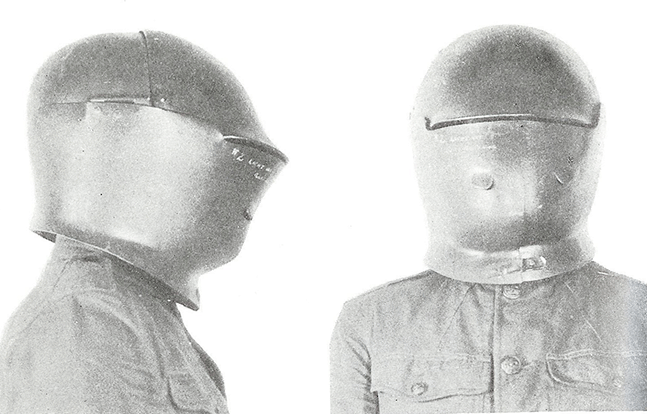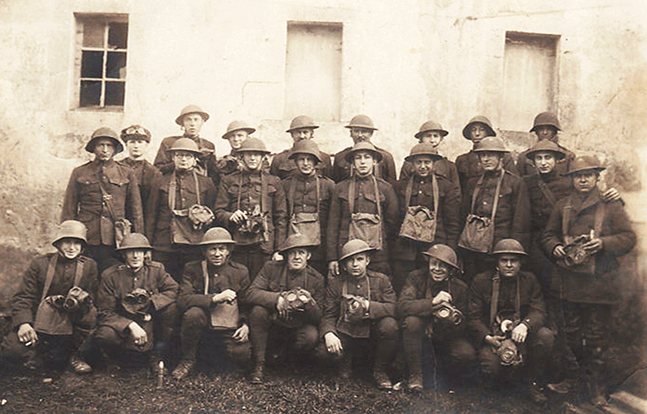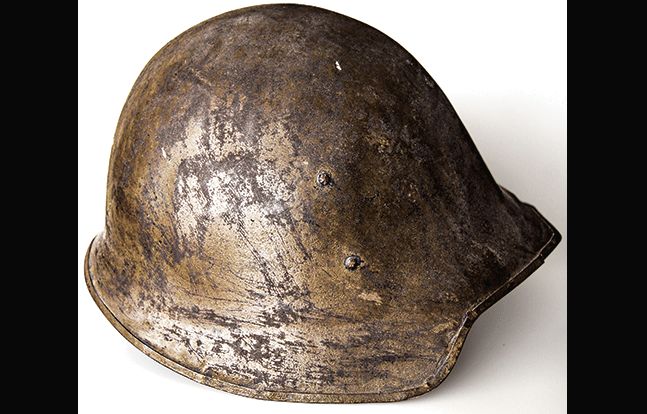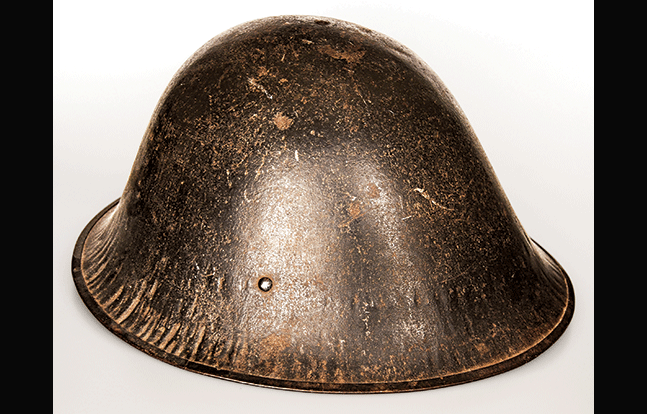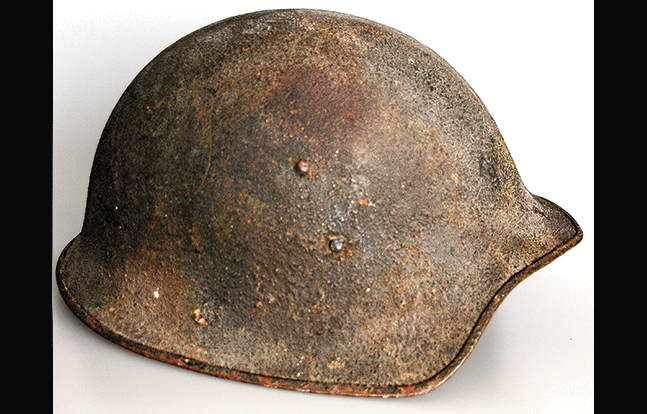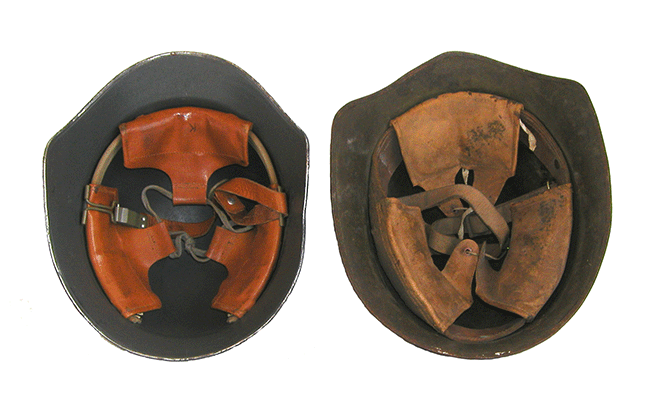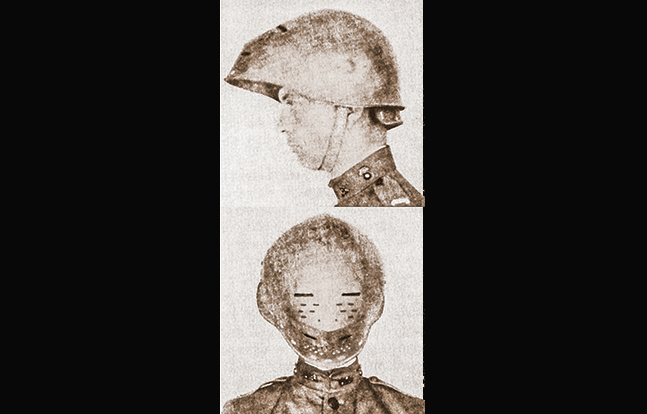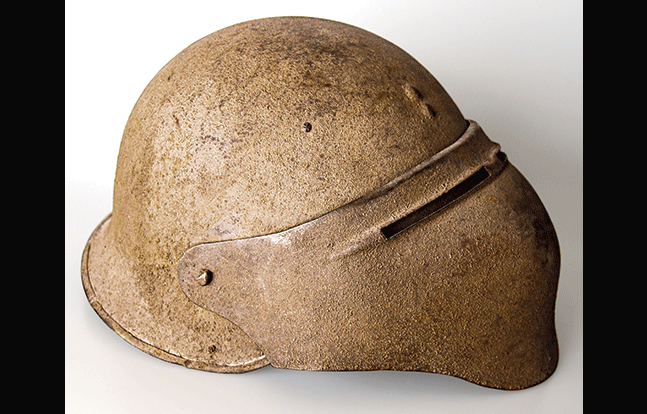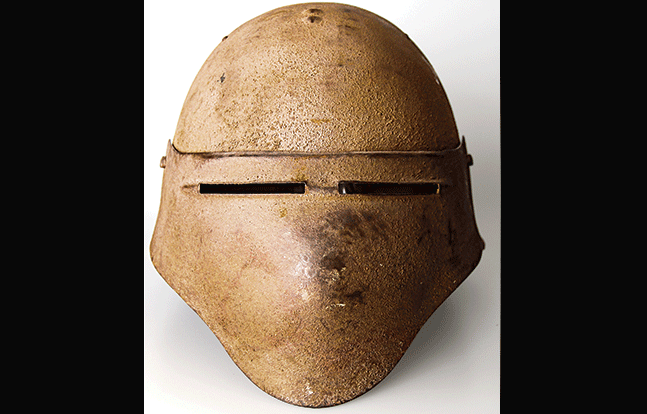Story written by Peter Suciu:
When the “Yanks” went “Over There” in 1917 they were forced to rely primarily on equipment from France and Great Britain. At the time the United States was actually rather unprepared for the conflict, but the nations of Europe had already been fighting in the trenches for nearly three years. In that time the front lines on the Western Front had become nearly static, with a line of trenches that stretched from Switzerland in the south to the English Channel in the north. This environment had caused the combatant armies to adapt their weapons, and thus the modern steel combat helmet was born somewhat out of necessity.
The Americans entered the war a little ahead of the game as the soldiers actually arrived in the trenches with helmets. In the case of these helmets, the American Expeditionary Force was provided with the British Mk I steel helmet, which was made under contract in the United States as the Model 1917. Additionally, other units, notably ambulance drivers and the all-black combat division, the 93rd Infantry Division, wore French-produced Model 1915 “Adrian” helmets. But despite the adoption of the British helmets and limited use of French helmets, American military planners were actually working on an original American helmet. The results would be deemed “experimental” helmets by collectors today.
Advertisement — Continue Reading Below

Dr. Bashford Dean
As with many military projects, the development of the American steel helmet involved a number of people. However, one individual stood out who guided the process in these early years. This man was Dr. Bashford Dean, and thanks to his research and later efforts to chronicle the helmets, a great deal is actually known about these American helmets.
Dean, along with the other members of the Ordnance Corps, also had an advantage over the other attempts to devise a modern helmet. For one, he and the team were able to design and test their helmets from the relative safety of the Aberdeen Proving Grounds in Maryland. He was also able to draw upon what had already seen field-testing and learned from what worked and what didn’t. However, as with the helmet designers in France, England and Germany, there was an urgency to produce the best helmet to protect the soldiers in the field.
Advertisement — Continue Reading Below
Born in 1867, Dean was an interesting character. He was an American zoologist and armor expert, and served on the board at both the American Museum of Natural History and the Metropolitan Museum of Art. A graduate of the College of the City of New York, Dean earned his Ph.D. at Columbia University, where he taught zoology. He was also a noted authority on medieval arms and armor, and as a curator at New York’s “Met” he established the arms and armor collection in 1912. Dean oversaw the rapid growth of this collection, and through his world travels acquired many impressive items, notably the largest collection of Japanese armor outside of Asia. He even acquired many of the “second best” items for himself, which in turn inspired a generation of American collectors of the era, many of whom would later make generous donations to the museum. It should also be noted that when Dr. Dean died in 1928, he left his own collection of more than 1,000 pieces to the Met, where the gallery is now named in his honor.

Dean’s greatest contribution to the world of helmet collecting actually was his book, Helmets and Body Armor in Modern Warfare. First published just after his death by the Yale University Press, this book has been the premier reference for helmets of the early 20th century.
Advertisement — Continue Reading Below
With America’s entry into the Great War in 1917, Dean was appointed to the rank of major in the U.S. Army’s Ordnance Corps, and the Metropolitan Museum of Art placed its Arms and Armor Department at the disposal of the war effort. During this time the team, which included other scientists, metallurgists and designers, began to look at the helmets currently in use by England, France and Belgium, and even considered captured helmets from Germany.
The effort to develop an American helmet began in earnest just after America’s entry into the war, and continued until shortly after the end of hostilities in Europe. For nearly three years, Dean and others designed no less than 16 helmets. While some of the models were single prototypes, others were produced in the thousands. Some of the test subject models were even field-tested in Europe, and while not adopted as official helmets of the U.S. military, these can of course be considered combat helmets in their own right.
Experimental Designs
Advertisement — Continue Reading Below
Ironically missing in the list of “experimental helmets” seems to be a so-called “Model 1.” Instead, it can be assumed that perhaps the Model 1917 was considered the “first” model. Alternatively, perhaps the most original idea never made it off the drawing board. At any rate, for collectors, the numbering essentially begins with the Model 2.
Designed in June of 1917, this helmet aimed to protect more completely the sides and back of the head. The Model 2 was based on the “standard” helmets of classical Greece and Italy in the 15th century, and this particular design even saw limited field testing during World War I. The helmet was found to be comfortable to wear and provided satisfactory ballistic results. Some 2,000 Model 2 helmets were produced by Ford Motor Company of Detroit, Michigan. Its failing was that it was too familiar. Deemed to be too similar to the German Model 1916 helmet, it was discarded and taken out of consideration.
As with the Model 1, the Model 3 is not mentioned in Dean’s book and records don’t indicate that such a helmet existed. Subsequent books, including those by author/collector Chris Armold, suggest that this pattern may have been one of many so-called one-of-a-kind experimental helmets shown in photographs from the era. To date, no information has come to light regarding the Model 3.
Advertisement — Continue Reading Below
The Model 4 was actually produced in small numbers by armor expert Daniel Tachaux of the Metropolitan Museum of Art. Tachaux had also been one of the original designers of the Model 2, and worked closely with Dean throughout WWI. The Model 4 took the basic shape of the British Mk I/American Model 1917 but produced a deeper bowl that sat lower on the head. The look is reminiscent of a medieval “Man at Arms” helmet. The only known surviving example is housed at the U.S. Army Ordnance Museum.

One of the more common experimental helmets to have survived is also the one that apparently saw some usage in the trenches in France. This is the Model 5, which has the basic deep bowl features of the Model 2. It reportedly was as easy to produce at the Model 1917/Mk I-pattern helmet. Its dome protected the wearer’s head while not impairing vision.
The Model 5 used a three-pad liner system with a canvas chinstrap, a feature first adopted in the Model 2, and no doubt “borrowed” from the German Model 1916 “coal scuttle” helmet. About 2,000 of these experimental helmets were produced by the Philadelphia firm of Hale & Kilburn, but unlike the Model 2, this helmet design actually saw limited testing in the trenches in France at the end of WWI. Despite this, it was deemed (like its predecessor) to look too close in shape to the German Model 1916 helmet and was thus not adopted by the U.S. Army.
Advertisement — Continue Reading Below
Tachaux also devised the Model 6, which featured the novel concept of tilting forward. In the up position it was a basic helmet with a long visor, but in the lower position the brow doubled as a facemask. It was considered unbalanced and awkward to wear, and when in the down position provided virtually no protection to the back of the head. It was only produced as a concept, and thus no ballistic testing was ever done. Today, the only known example of this model is in the collection of the U.S. Army Ordnance Museum.
The Model 7 was yet another “blast from the past” in terms of design. It is not known if this unique-looking helmet—which resembled something a medieval knight in shining (or mud-covered) armor might have worn—was ever field-tested, but to date only three examples are known to have survived. The helmet was a round bowl that protected the top of the head while two flaps closed in on the sides. Those who tested it claimed it was heavy and uncomfortable to wear, limiting the field of vision. According to Dean’s writings, the Model 7 was produced by W.H. Mullins Company of Salem, Ohio, in three different weights, including 11, 15 and 18 pounds, which may indicate that one of each size/weight was produced. Also known as the Sentinel’s Helmet, the surviving examples are known to be in the collection of the U.S. Army Ordnance Museum and the Imperial War Museum in London. A third example was owned by Robert Wilson of the Wilson History & Research Center until his untimely passing in 2012. That example was offered for sale for $42,000.

The Model 7 may have influenced the design of the Model 8, which featured the basic shape of the Model 5, but with a visor to protect the wearer’s face almost completely. The manufacture of the Model 8 was undertaken by Ford Motor Company of Detroit, Michigan in November 1918. About 1,300 helmets of this model were produced and it featured a three-pad liner system similar to the ones found in the Model 2 and Model 5. The benefits of this helmet were that with the visor down it does protect the face almost entirely, while the slits would provide reasonable field of view. Arriving just as the Armistice was signed, the Model 8 never saw service in France, and likely was set aside and never field tested. As a result it is one of the more “common” and unique experimental helmets to survive from this period.
Advertisement — Continue Reading Below
The Model 7 was not the only full head helmet, and a one-of-a-kind prototype Model 9 revisited this design, but little else is known about it. Only photos of this particular pattern remain. In addition, the concept of a full bowl helmet was revisited once again with the Model 10, which was produced in very limited numbers in the summer of 1918. According to Dean, some examples were sent to France for further testing, but it is also unknown whether these were actually used in combat or if these arrived after the end of hostilities. The only known surviving specimen is in the collection of the U.S. Army Ordnance Museum.
Several other models—such as the Model 11 and Model 12—may not have existed at all beyond the drawing board, but the Model 13 was designed as the first prototype tanker helmet, while the Model 14 and Model 15 were designed as flight helmets. These weren’t so much the last of the American experimental helmets, but rather the beginnings of specialized helmet designs that would continue for many, many years.

The Liberty Bell
Advertisement — Continue Reading Below
There is one other American experimental helmet that also stands out. It seems not to have a number and was simply called “The Liberty Bell.” Perhaps it was in fact even the Model 1, but to date no evidence has surfaced that would clarify that point.
It has been long believed that the name originated because of the helmet’s unique shape, which does sort of look like an off-center bell. According to a Stars and Stripes article dated from November 1918, some models of this design were stamped with an impression of the Liberty Bell on the front. For a long time this was believed to be an embellishment (or even a misunderstanding) on the Stars and Stripes author’s part.
What is known is that the helmet pattern was designed by Major James E. McNary and submitted to the American Helmet Committee for consideration as a replacement for the Model 1917 helmet. It was initially accepted but was disliked by the troops, who compared it to a dome-like hat of a Chinese fisherman. The helmet was officially abandoned as a replacement helmet in 1920. Interestingly, the basic shape of the helmet has been compared to the British Mk III “Turtle Shell” design, which was adopted nearly 25 years later!
What is also notable about this pattern is that several different liner types and chinstraps were used with the Liberty Bell, including a three-pad system similar to the German Model 1916, a liner that was basically a holdover from the Model 1917, and the final version, which was an oil cloth donut-type liner that was supported with four springs that acted as shock absorbers.
Conclusions
Ironically, for both the soldier at the time and the collector today, the best efforts to design a better helmet were unsuccessful, and as a result the generally inferior Model 1917 remained in service, only being upgraded as the Model 1917A1 in the late 1930s until the arrival of the M1 helmet in 1940. And while none of these would-be helmets went on to be Dean’s final legacy, his designs and understanding of armor, as well as those of Tachaux and others, did help influence later designers to craft better headgear and protect our troops in combat. For that we should be eternally grateful.
